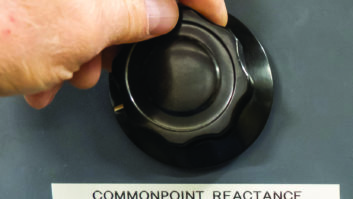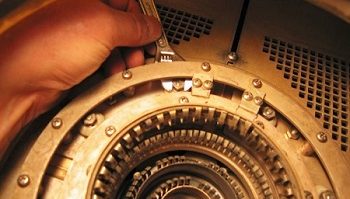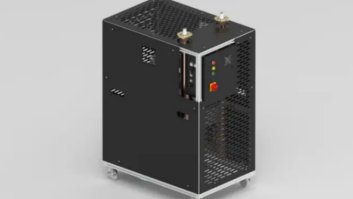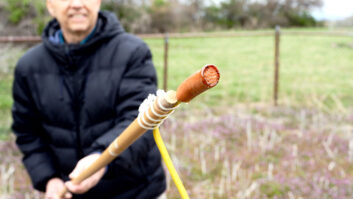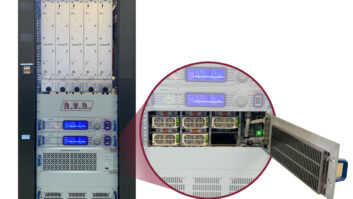What better way to celebrate Groundhog Day than with a resolution to commit to furthering your education?
Are you SBE Certified? Did you know that the SBE sends a letter of congratulations to your boss — the station owner or GM — when you’ve successfully completed a level of SBE Certification? What better ammunition to use for a salary increase? If you’re looking for a new job, SBE certification is really the only officially recognized broadcast engineer certification program.
We’ve all got good intentions, but finding the time to study and take a test can be a challenge. So here’s an alternative.
(click thumbnail)Fig. 1: These coax toroids were heating to 120 degrees.Start out with some baby steps by signing up for a free series of four one-hour webinars starting later this month and sponsored by my day-job employer, Broadcast Electronics. The series will be based on the AM-FM Transmitter Workshop I’ve offered at NAB spring and fall conventions.
These will be the first webinars in BE’s Radio Pro Online School 2008. You will not only learn but also earn SBE recertification points by attending all four sessions, and pick up some tips at the same time.
Whether you are an engineering newbie or have worked on more transmitters than Abraham has ancestors, these sessions offer practical information you can use. Basic AM and FM theory will be explained in the first session, and a session on troubleshooting real-world transmitter problems is included.
Also covered will be routine maintenance techniques for engineers managing multiple sites, along with a survey of potential HD Radio installation problems for those planning a future HD Radio upgrade.
The workshop consists of four one-hour sessions to be conducted on Feb. 19, 21, 26 and 28 at 4 p.m. ET. Participants will be able to contribute questions; the sessions will be archived for later streaming for those who cannot attend in real time.
(click thumbnail)Fig. 2: Braided grounding for the coax shields was suspected.Certified SBE engineers who participate in all four (live or offline) may be eligible for one-half credit towards SBE recertification. See http://sbe.org/Cert_Maint.php for details. No credit is available for attending fewer than four sessions.
Enrollment opens on Feb. 4 and is open and free to all broadcast professionals, as well as those training in the field.
You can register or get more information by heading to www.bdcast.com.
* * *
Michael Barnes is the technical director for the Salem Radio Network in Irving, Texas. Michael asks if you’ve priced rack-mount brackets for LCD monitors lately. You may find they cost more than the monitor itself!
He offers a solution that is less expensive but equally effective. He bought an inexpensive wall-mount bracket used to mount these monitors, then fastened it to a 4RU 19-inch rack panel.
The whole thing ran less than $25, and the LCD monitor mounts easily to the panel bracket. Screw the rack panel into the rack and the problem is solved.
(click thumbnail)Fig. 3: Everything is normal after the lines were grounded properly.This is probably not the best solution for a showcase studio but it works great in a rack room or anywhere else you need a rack-mounted monitor and where aesthetics aren’t number one on the list.
If you implement this idea and save your station several hundred dollars, let your manager know. These kind of simple tips remind the GM that you’re keeping the bottom line in mind as you manage your engineering department.
* * *
Engineers enjoy case histories. Here’s an interesting one from Laverne Siemens of Canada’s Golden West Media.
About two years ago, Laverne and his crew installed a Nautel XR-12 transmitter at one of their sites. After the installation, they noticed that the coaxial toroids, shipped by the company and installed on the transmission line and control lines had been running too warm.
Laverne checked for ideas with the factory; they offered tips on grounding and even shipped extra toroids. The crew worked on the grounding around the building and inside as well, but with no improvement with respect to the heating issue.
Using an infrared thermometer, Laverne was getting readings of about 50 degrees Celsius (122°Fahrenheit) on the toroids. Finally he zeroed in on the RF contactor that is in line between the coax from the transmitter and the one going out to the towers. It is there to switch in the standby transmitter — which hasn’t had to run once in two years. (Aren’t new transmitters great?)
The people who built the site — not Laverne’s crew — had chosen to tie the grounds of the coaxes coming to the contactor together with copper braid, seen in Fig. 2. The braids were clamped to the coaxes with hose clamps and in turn tied to the building ground strap.
(click thumbnail)Fig. 4: A handheld digital thermometer can zero in on hot spots.On a hunch that the braid had too much resistance, Laverne and his staff redid the entire contactor installation by mounting it on an aluminium panel and then using proper coax mounting clamps to ground the coaxes to that panel, as shown in Fig. 3.
The ground strap was then bolted to the panel as well. The toroids are now running at room temperature of 15°C, 59°F.
* * *
If you haven’t taken the plunge and purchased an infrared thermometer, you’re missing out on a great maintenance and diagnostic tool.
In addition to locating RF hot spots, as Laverne did, the thermometer can zero in on stressed ICs, and even spot loose connections or bad AC breakers — before they take you off the air.
Fluke announced its new model 566 Thermometer, pictured in Fig. 4. The rugged handheld thermometer combines contact and non-contact temperature measurement capability in an easy-to-use tool. The company promises 1 percent accuracy, the thermometer will span a temperature range of –40°F to 1202°F.
The Fluke 566 Thermometer is available at list price of $379, one in a series of temperature measuring devices the company manufactures. For information visit www.fluke.com.









